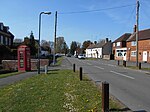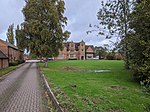29th Division War Memorial
Buildings and structures completed in 1921Grade II* listed buildings in WarwickshireGrade II* listed monuments and memorialsMonuments and memorials in WarwickshireWorld War I memorials in England

The 29th Division War Memorial is a war memorial beside the junction of the A45 and the B4455 near Stretton-on-Dunsmore, near Rugby, Warwickshire. It commemorates the service of the British 29th Division during the First World War. The memorial became a Grade II listed building in 1987, upgraded to Grade II* in 2015, and it is described by Historic England as "probably the most significant single memorial in Britain associated with the Gallipoli campaign".
Excerpt from the Wikipedia article 29th Division War Memorial (License: CC BY-SA 3.0, Authors, Images).29th Division War Memorial
Memorial Island,
Geographical coordinates (GPS) Address External links Nearby Places Show on map
Geographical coordinates (GPS)
| Latitude | Longitude |
|---|---|
| N 52.35592 ° | E -1.39226 ° |
Address
The Incomparable 29th
Memorial Island
CV23 9NR
England, United Kingdom
Open on Google Maps










